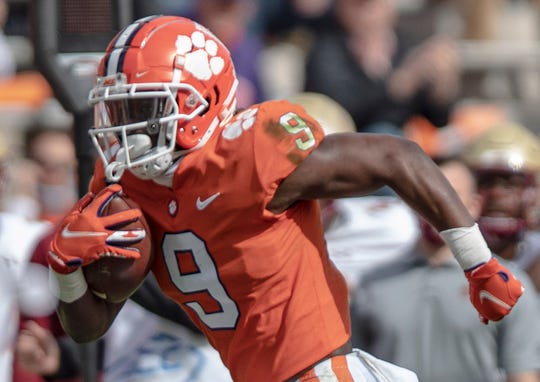2021 NFL draft running back rankings: Travis Etienne, Najee Harris lead the RB class
The 2021 NFL draft will occur across downtown Cleveland locations that include FirstEnergy Stadium (home of the Browns), the Great Lakes Science Center and the Rock & Roll Hall of Fame. NFL Commissioner Roger Goodell and a select number of prospects will take the stage.
The first round will be held on Thursday, April 29. Rounds 2-3 will take place on Friday, April 30. Rounds 4-7 will be held Saturday, May 1. The draft will be broadcast on ABC, ESPN and NFL Network.
USA ToDAY Network NFL reporters break down the draft position-by-position. Here are the top running back prospects:
1. Travis Etienne, Clemson
Pros: Excels at picking up yards after contact with a fall-forward mentality. Quick and shifty enough to miss contact in a phone booth with late adjustments. Explosive and fast enough to run away from defenders in the open field.
Cons: Won’t always take what is given to him. Vision is questionable on short-yardage carries and doesn’t run with enough patience.
Travis Etienne rushed for 4,952 yards during his four seasons at Clemson. (Photo: Josh Morgan, USA TODAY Sports)
2. Najee Harris, Alabama
Pros: Light, accurate, and efficient on his feet, fully capable of moving in and out of breaks with balance, precision, and control. Naturally makes himself small and slippery when necessary. Improved and excelled as a receiver each year of his career.
Cons: Will sometimes give up too much on outside runs as he waits for his running lane. Long speed and acceleration are questionable.
3. Javonte Williams, North Carolina
Pros: Physical and aggressive style of running that will take advantage of poor tackling every time. Ideal blend of physical and tough but also graceful and quick. Will take every inch that is given to him. Excels in short-yardage situations.
Cons: Can be caught from behind. Base speed and agility are average at best. Body catcher when the ball is thrown his way.
4. Kenneth Gainwell, Memphis
Pros: Has a way of maneuvering in and out of contact while staying square to the end zone. Has powerful and explosive burst. Elite pass catcher. Can be moved at the offensive formation, giving the play-caller multiple options. Runs hungry and feisty.
Cons: Undersized and lacking lower-body push. Won’t move piles and won’t escape an honest, solid tackle attempt. Poor blocker who won’t sustain good contact.
5. Michael Carter, North Carolina
Pros: Tough with excellent contact balance and acceleration. Shoots out of a cannon with easy change of direction. Couples that movement capability with
excellent vision. Consistent hands catcher who can get balls away from his body. Runs good routes out of the backfield; knows how to set linebackers up.
Cons: Size will limit him within certain roles of the position. Poor impact as a blocker. Top-end speed doesn’t match his quickness.
6. Khalil Herbert, Virginia Tech
Pros: Excellent vision plus burst combination as he approaches the line. Will hit a high gear the instant he gets the ball, doesn’t waste time. Shows late bend to maximize his space angles. Physical, low-to-ground runner. Just one career fumble included in his 508 career touches.
Cons: Will get too dependent on the jump cut. Will get a little too hoppy. Never a key piece to the passing game.
7. Trey Sermon, Ohio State
Pros: Angry and physical downhill runner who can slash his way to the second level. Has last-moment twitch and explosion. Fast eyes match his ability to burst. Takes what the defense gives while maintaining the balance and concentration to adjust to new cutback lanes.
Cons: Has a tendency to run high and take on too much contact from a disadvantageous position. Was never featured much as a pass catcher.
8. Demetric Felton, UCLA
Pros: Versatile threat who has a credible amount of receiving and rushing skills. Can shake his way in and out of contact with a defender. Can set would-be tacklers up and make them miss in tight spaces. Won’t shy from contact and will push tacklers back.
Cons: Short-area quickness doesn’t have the next gear. Easy to take down for defenders when they get two hands on him.
9. Kylin Hill, Mississippi State
Pros: Has excellent footwork and lower-body quickness. Packs punch on contact but will also run wet and slippery to defenders. Decisive runner. Really good hands with a developed route-running skill set. Just one fumble over 519 career touches.
Cons: Can take a little too long to really get going. Won’t be a pile pusher and is much more effective in space than he is in traffic.
10. Chuba Hubbard, Oklahoma State
Pros: A big-play back who can break off the deep runs and run away from all defenders. Moves with uncanny control and balance while moving at his top rate. Displays good cutback vision and is a sound decision-maker.
Cons: Had significant fumble issues early in his career. Needs to clean up his ball skills, both as a handler and pass catcher.
NEXT BEST
11. Larry Rountree III, Missouri
12. Stevie Scott III, Indiana
13. Jaret Patterson, Buffalo
14. Javian Hawkins, Louisville
15. Rhamondre Stevenson, Oklahoma
16. Elijah Mitchell, Louisiana
17. Gary Brightwell, Arizona
18. Chris Evans, Michigan
19. Trey Ragas, Louisiana
20. Rakeem Boyd, Arkansas
21. Gerrid Doaks, Cincinnati
22. Jermar Jefferson, Oregon State
23. Brenden Knox, Marshall
24. Mekhi Sargent, Iowa
25. Deon Jackson, Duke
26. Vavae Malepeai, Southern California
27. Josh Johnson, Louisiana-Monroe
28. Jake Funk, Maryland
29. CJ Marable, Coastal Carolina
30. Caleb Huntley, Ball State
31. Ben Mason (FB), Michigan
Source: Read Full Article

